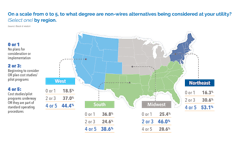DERs and Non-Wires: Merging Planning Teams
Utility managers who’ve long been content simply working in their own corners of the sprawling energy world appear to be increasingly setting aside those silos, at least when it comes to planning. That’s a nontraditional approach but almost a necessity as the power sector undergoes a transformation, pressing utilities to accommodate distributed energy resources (DERs) and non-wires alternatives (NWAs).
Such a shift is reflected in Black & Veatch’s 2020 Strategic Directions: Smart Utilities Report, where nearly half — 46% — of respondents to a survey question about how their organizations rated the importance of integrated planning voted "very important." An additional 35% went with "extremely important." Those replies, combined with those who said it was slightly or moderately important, means that virtually all respondents — 96% — believe that planning teams should include representatives from various functions from transmission to distribution and resource planning.
Regulatory pressure on the U.S. coasts and Hawaii explains why NWA solutions are closer to being adopted in the Northeast and West, while utilities elsewhere are just starting down the NWA path.
Looking ahead, NWAs could well become more prevalent as climate change becomes a national imperative, coal plants are under fire and continue to be retired, and electric vehicle (EV) adoption remains on the rise.
These circumstances will influence regulatory decisions and infrastructure requirements at the local and national level. This survey shows two-thirds of respondents saying they see drivers happening now or ahead that will prompt their utilities to consider the NWA approach to meeting system needs.
NWAs offer one way that utilities can add more renewables, thereby supporting sustainability goals while helping with reliability and resiliency. This is a major driver behind the New York REV initiative that Governor Andrew Cuomo launched as a comprehensive energy strategy for the Empire State.
NWAs also provide cost savings — seen in the ConEd Brooklyn Queens project, which was designed to defer a US$1.2 billion substation investment with a US$200 million program. And NWAs are flexible — a must for a greener grid.
All of this explains why NWAs will continue to gain sway, along with integrated system planning. Distribution, transmission, and resource mix will all be impacted by DERs and NWAs. Utilities know this and their planning approach is evolving accordingly.
About the Author
Heather Donaldson
Heather Donaldson is director of Black & Veatch Management Consulting, where she is responsible for supporting clients through grid modernization, DER integration, and other transformations.
Stuart McCafferty
Stuart McCafferty is a managing director focused on DER integration for Black & Veatch Management Consulting. He is a National Institute of Standards Technology (NIST) fellow for community resilience, an industry expert for Energy Central, and vice-chair for Open Field Message Bus (OpenFMB) Users Group.
Soundrapandian Sankar
Soundrapandian Sankar is the group leader for power system studies for Black & Veatch's power business, where he is responsible for supporting clients through distribution and transmission planning. He has provided consulting services to clients in North America, Europe, Asia, Africa, and New Zealand.



